#John Quincy Adams Ward
Text


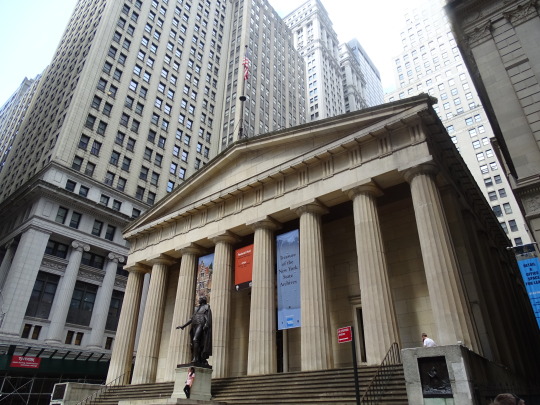





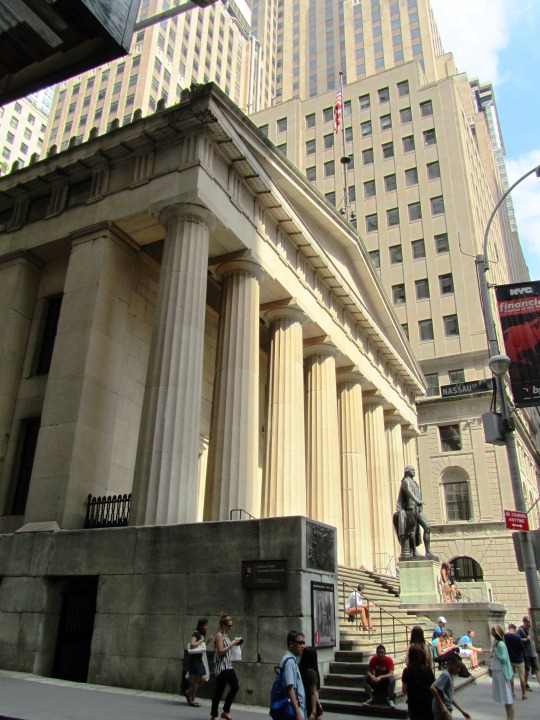

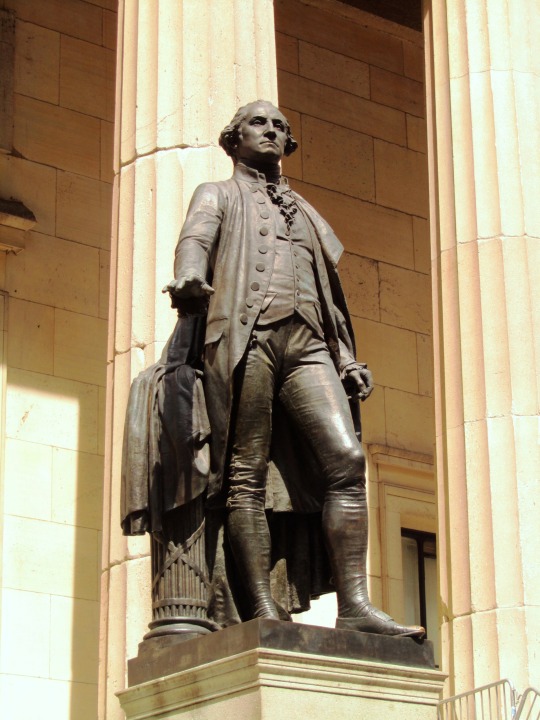
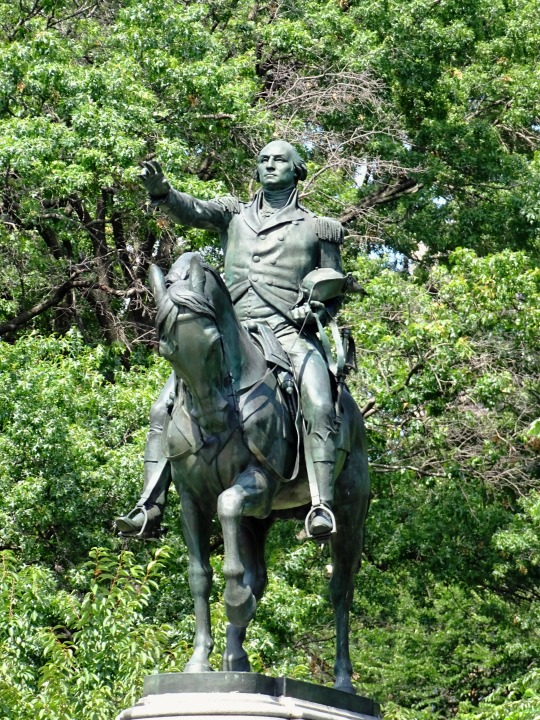



On the balcony of Federal Hall on Wall Street in New York City, George Washington takes the oath of office to become the first elected President of the United States on April 30, 1789.
#George Washington#takes the oath#first elected President of the United States#1st US president#Federal Hall#Lower Manhattan#New York City#30 April 1789#235th anniversary#US history#architecture#sculpture#public art#façade#Greek Revival architecture#Federal Hall Memorial National Historic Site#landmark#tourist attraction#John Quincy Adams Ward#USA#summer 2013#travel#vacation#tourism#original photography#cityscape#Mount Rushmore National Memorial#South Dakota#2018#2019
6 notes
·
View notes
Text
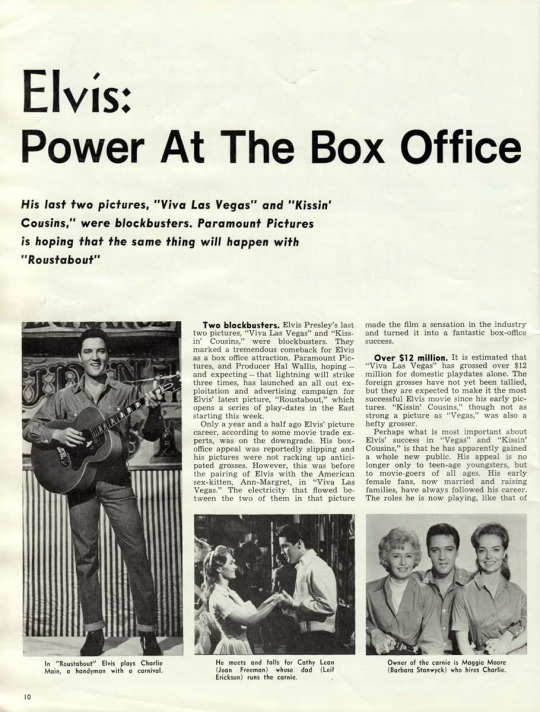
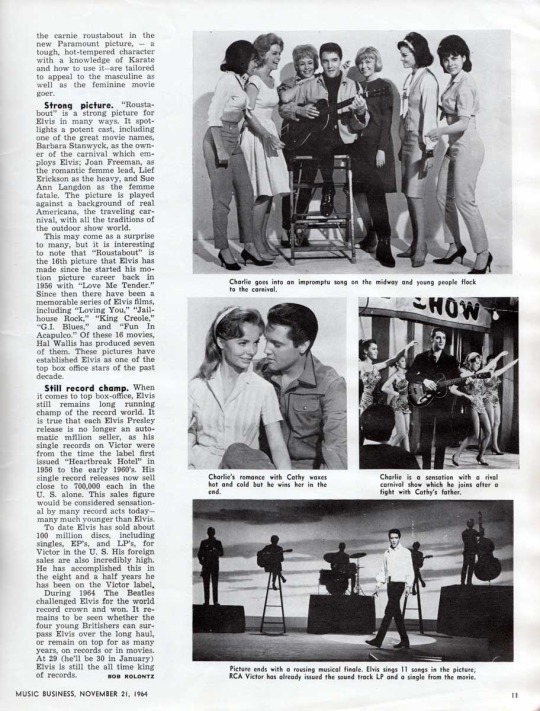
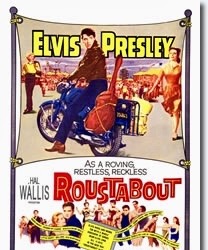


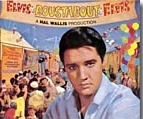
Elvis Presley Events In History Today The 21st November in 1964 Is Sixteenth Movie Was Premiered In Hollywood. Roustabout By Paramount.
Elvis Presley’s sixteenth movie was the 1964 Paramount film 'Roustabout'.
Playing opposite Barbara Stanwyck this time out in Roustabout, Elvis Presley was in awe of his costar and worked hard to live up to her professional standards. Unfortunately, the scriptwriters were less demanding of themselves, and the film suffers from banal dialogue and predictable plotting. Elvis Presley starred as Charlie Rogers, a drifter with a chip on his shoulder who lands a job as a roustabout, or handyman, with a down-and-out carnival operated by strong-willed Maggie Morgan, played by Stanwyck. When Charlie breaks into song on the midway one day, throngs of young people flock to hear him sing. As news of his talent spreads, Maggie's carnival begins to turn a tidy profit. Charlie's good fortune continues as Cathy, a beautiful young carnival worker played by Joan Freeman, takes a romantic interest in him. However, after a misunderstanding involving a customer's missing wallet, Maggie and Cathy chide Charlie for his selfish attitudes. The embittered young man quits Maggie's outfit to work for a rival carnival. When Maggie's carnival starts to go under, Charlie returns with enough money to ward off the creditors. His unselfish act wins Maggie's respect as well as Cathy's heart. Having at one time been a carnival worker, the idea for a picture with a carnival background had been that of Colonel Tom Parker, Elvis Presley’s manager. However, Colonel was adamant that the movie 'not cheapen carnival life....that this was a wholesome way of life in which the participants had a legitimate pride'.
The movie was first announced in May of 1961, but production was delayed until March of 1964. In the time between there were changes. Among them were: that the working title went from 'Right This Way Folks' to 'Roustabout'; that Elvis Presley’s character name changed from Charlie Main to Charlie Rogers; and that the character of carnival owner Maggie Moore changed to Maggie Morgan; and that the actress chosen to play Morgan changed from Mae West to Barbara Stanwyck. The writers were Anthony Lawrence and Allan Weiss.
Anthony Lawrence later worked on the scripts for the Elvis movies 'Paradise Hawaiian Style' and 'Easy Come, Easy Go' and the 1979 TV biopic 'Elvis', starring Kurt Russell in the title role. Among his other credits are a number of TV series including 'The Fugitive', 'Hawaii Five-O', 'Cannon', 'Quincy' and 'The Blue Knight'.
Allan Weiss was the screenwriter for the Elvis Presley’s flims 'Blue Hawaii', 'Girls! Girls! Girls!', 'Fun In Acapulco', 'Paradise Hawaiian Style' and 'Easy Come, Easy Go'. He once remarked that the scripts were written to producer Hal Wallis's specifications: 'Wallis kept the screenplays shallow'.
'I was asked to create a believable framework for twelve songs and lots of girls'. However true this was, both Mr. Lawrence and Mr. Weiss received a nomination from the Writers Guild of America in 1965 for their work on 'Roustabout' as the Best Written American Musical of 1964.
The director was John Rich and this was his first time to work with Elvis Presley He came from a strong background in TV, having directed such series as 'Our Miss Brooks', 'I Married Joan', 'Gunsmoke', 'The Rifleman', 'The Andy Griffith Show', 'The Dick Van Dyke Show' and 'Gilligan's Island'. He was anxious to break into film directing with Hal Wallis. He wasn't impressed with Elvis Presley’s Memphis Mafia entourage and their constant hanging around and playing practical jokes on one another. Elvis Presley told Mr. Rich, '...when these damn movies cease to be fun, I'll stop doing them. And if my guys go, (expletive), so do I'. Elvis Presley and Mr. Rich had gotten off to a shaky start when Elvis Presley cajoled the director into allowing him to do his own stunt fight, which was very uncommon then due to the possibility of the star's being hurt and shutting down production. When Elvis Presley indeed was hurt in the stunt and required several stitches above his eye, Mr. Rich was afraid to tell Hal Wallis that he'd allowed their star to become injured. Then he came up with a plan to write into the script the bandage that covered the stitches and thus production wasn't halted and Wallis was appeased. John Rich later directed Elvis in 'Easy Come, Easy Go'. By that time he was disillusioned with Hal Wallis and his methods and had developed a respect for Elvis Presley And No Big Star Had Ever Put Him Straight Like He Did When He Told If These Damn Movies Cease To Be Fun I’ll Stop Doing Them. He Really Admired And Respected Elvis Presley For Standing Up And Speaking Is Mind Although Parker Wasn’t Happy As He Pulled Elvis Presley Up Rich returned to directing TV series including such programs as 'All In The Family', 'Sanford and Son', 'Maude', 'The Jeffersons', 'Barney Miller', 'Newhart', 'Dear John' and 'Murphy Brown' among others. He has received many accolades including seven Emmy nominations with three Emmy wins.
On February 26, 1964, Elvis Presley reported to Paramount for pre-production. He started with soundtrack recording sessions at Radio Recorders of Hollywood. On March 3, Elvis Presley recorded the version of the title song 'Roustabout' that was written by Otis Blackwell and Winfield Scott. It was not used in the film. Instead they used a different song with the same title written by Bill Giant, Bernie Baum and Florence Kaye.
Elvis Presley recorded his vocals for that second song on April 29, 1964 after the principal photography was shot. An acetate of Elvis Presley’s long-thought-lost Blackwell/Scott song was found in Winfield Scott's basement and RCA first released it as a bonus track on the 2003 Elvis 2nd To None album. To differentiate it from the one used in the movie, the title was changed to 'I'm a Roustabout'.
Elvis Presley became frustrated during these sessions when he wanted The Jordanaires to back him up on a song that he would be seen singing alone in the film while riding a motorcycle down the road.
One of the producers questioned him as to where the backup singers would be in the shot.
Elvis Presley snapped back, 'The same damn place as the band!'
One of the songs in the film, 'It's A Wonderful World', written by Sid Tepper and Roy C. Bennett, was for a time in contention for an Academy Award nomination as Best Song.
For authenticity in Elvis Presley’s sixteenth film, 'Roustabout', a real carnival was employed and set up on land near Thousand Oaks, California. This was one of the locations used for exterior shots in the movie. The interior shots used three connecting sound stages (Nos. 12, 14 and 15) on the Paramount lot. The doors between them were opened up to make them into one huge stage, which was needed to accommodate the set for the big tent scenes. This was the first time in the history of the studio that they had done this.
13 notes
·
View notes
Text
Freedman Lean
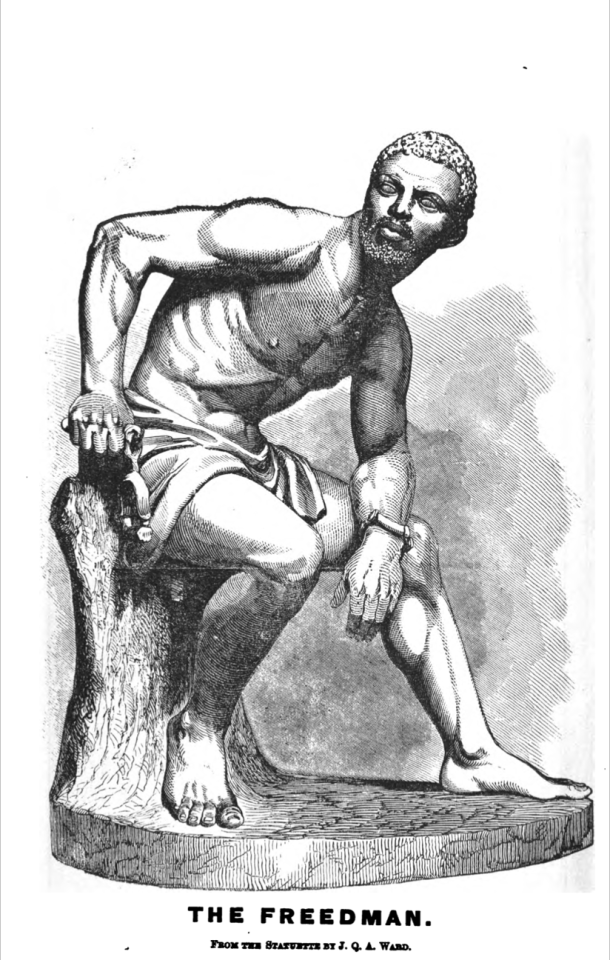
I
I had never seen the work before, still have not seen it as a sculpture, only as a picture of a sculpture, the picture in turn the frontispiece to the book I browsed—Brief Report of the Services Rendered by the Freed People to the United States Army in North Carolina, by Vincent Colyer, published 1864, only a year after the sculpture was made and shown, but by which time it was already regarded as an arresting depiction of black emancipation in the round—perhaps even the depiction of it, as John Adams Quincy Ward’s work may have been the first time black skin was translated into plaster and subsequently into bronze in American art.[1] A critic back then exclaimed—
A naked slave has burst his shackles, and with uplifted face thanks God for freedom. We have seen nothing in our sculpture more soul-uplifting or more comprehensively eloquent. It tells in one word the whole sad story of slavery and the bright story of emancipation.[2]
“Sad story”, “bright story”— in my consequent search to learn more about the work, it seemed this 1864 assessment itself told the long story short of the sculpture for subsequent commentaries remain within its range, emphasizing either the legacy of slavery or the possibility of freedom, along with the attendant histories of reception, construction, intention, and circulation that support either side. This two-way range makes sense given the historical context of the work in 1864, just as it makes sense given the contemporary context of the work in 2024 (“Observe that the ‘Freedman’ still grasps several links of his chain” wrote Freeman Henry Morris Murray in 1913. One kind of emancipation is only the beginning of another kind that itself is still just beginning.[3])
Yet, there is more here than the man, his shackles, his small fold of cloth, his slavery, his emancipation. There is also the stump upon which he “leans”—the tree is direct object of his action and direct support for his body and that is all anyone ever seems to remark of the tree, if any remarks are made at all.
II
It used to be said that you can tell whether a sculpture was a Roman copy or a Greek original depending on if there were struts or not.[4] The Greeks, the thought went, mostly used bronze, the Romans marble. Mineral and metal, in color, feel, source, and weight the two materials differ—and in tensile strength too. Bronze has some. Marble has next to none. So the Roman Wounded Amazon leans on a post that projects into her, just as the wide leg Roman Hercules holds a brick between his outspread legs, not to demonstrate his upright strength but rather to maintain it. The Discobolus player, so easily animated into full swinging motions from his marmoreal fragments, becomes a much more cumbersome image of independent mobility when the pieces are imagined all back together, the disk looking like a railroad sign protruding from his lower back. But his awkwardness is only so in our eyes and the way we have learned to look at sculpture (and also perhaps ourselves?) a way in which the human figure is understood to have come slowly out of mass and bulk, backgrounds of earth or rock or metal and slowly taken its own step forward into independent standing. So many struts in Roman sculptures are small subterfuges in the fantasy of figural self-sufficiency. Ignore them then or allege the Romans ignorant in taste for what other arguments can struts solicit? Like strings, plugs, tubes, screws and switches struts are what we prefer not to see as they dash the chance of imagined autonomy. To dream a Pygmalion into being—either out of stone, metal or of flesh— begins with believing a figure is already freed in its form so that another kind of freedom follows.
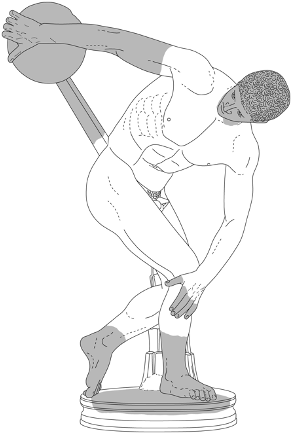
III
Report of the Services Rendered by the Freed People to the United States Army— the title summarizes the book. Vincent Colyer, an artist after the Civil War, was, during the war, the “Superintendent of the Poor for the Union’s Department of North Carolina.” His first task was “to employ as many negro men as I could get, up to the number of five thousand” to build forts. Once these places for defense were made, plans for espionage and offensives followed and as efforts turned in their favor, processes of repair in the built and social landscape could be undertaken. Of one such moment Coyler recounts that,
On Roanoke Island, the blacks, for want of a church edifice, had constructed a spacious bower, cutting down long, straight, pine trees and placing them parallel lengthwise for seats, with space enough between for their knees—constructing a rude pulpit out of the discarded Quartermaster’s boxes, and overarching the whole with a thick covering of pine branches.[5]
They were leaning on the trees; they were praying under pines.

IV
It could be said that the tree holds the man up rather than that the man sits on the tree. Semantics someone says. Exactly, I agree—meaning depends on priority, sequence, and relations, in short, context.
V
His right foot is preparing. Whether preparing to kick off from the stump or relax onto it cannot be decided. The foot could do either in part because the stump can be either a place to launch from or a place to lay on. Supports are not just passive, but they must be able to bear the needs of the supported, some needs of which are obvious (maintaining uprightness), some of which are obscure. What does the tree do for the freedman aside from being a convenience for him? Alternatives could be imagined: a rock, bare ground, a chair, a stool. He could lean or sit on any of these, though each would alter the work, veer it towards different meanings. Chair or stool suggests some room’s interior, but the emancipation of the Freedman with his shackles and loincloth connotate a struggle that has occurred outside. A rock or bare ground then would be better, though if he were on bare ground the work would lose its quality of liminal ascent, its feeling that the man has a chance to choose his next move; instead of wondering what one can do as a free man, on bare ground he would have to ask a more basic question again “Am I not a man and a brother” as the slave on the coin asked from his position on the ground, unsure if his humanity was recognizable.

A sizeable rock then is perhaps the only alternative to the tree stump, not too architectural, not too abject, though it too would not be a perfect synonym of support—it could even be antonymic. Though both natural objects, stones are heavy, hard and seem to always have been where they were just as they seem they always will be. To a degree trees are the same, but that we call the tree which the Freedman leans upon a stump already indicates its changeableness. Its top has been cut down, worked by hands (perhaps his hands), the trunk dragged some time ago to mill and market, supporting as many endeavors as wood does for humans. Its top supporting others, the bottom of the tree in turn seeks to be supported itself by the ground. A stone has ground underneath it too, but a tree holds its ground—even in death its trunk flares and the soil slopes from the man’s right foot to his left as the tree’s roots reach deep below to hold up the stump that holds up the man who wants to hold onto his freedom. No act is wholly self-sufficient, but each reaches out to make relations to bring itself into being, sometimes these relations are brief—the man will not lean long on the tree—sometimes these relations will be coextensive with life—this tree died rooted where it first broke ground.
VI
Some say what the man looks out to, or rather for, is danger—men who cannot bear the thought of his freedom, for what kind of relation beyond subjugation could they imagine. And maybe that fear does dog him here back then on the tree stump, just as it may here right now on the deck chair, as Huge Hayden imagines.
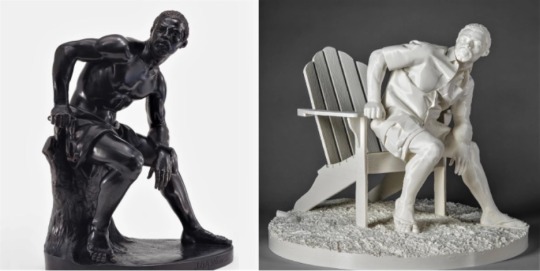
However, there has to be more on his brow than the apprehension of another arrest. His gaze is attentive but not anxious; one hand is easy, one hand tense. So specific in visage, he does not conjure up a community of black folks by allegory so much as by implication; he must have family, he must have friends—maybe he waits for them to join him, not on the small raft of ground visible under his feet, but on ground that must be broader, because the tree, so specific in its form too, also implies others like it around which altogether make a forest that surrounds the man and any others like him, surrounds them with a of forest sounds and scents and smells and sights, surrounds them with its support as it always has, though before now whatever sentiments so much sensation may have offered was at all times subject to the censure of enslavement—a shackle upon feeling as well as the feet. This sudden strange new world of his where one can just sit and sense must feel as much, if not more a strain as the one in which sitting and sensing where secrets done in the shadow of oversight. The relations of the world from which he escaped were chain tight and determined, you got just the bare minimum of ground to survive. The relations of the world he might enter seem at once infinite and nonexistent. When he is ready, the remnant limb of the tree on which his right hand is placed will be what helps him stand up, the remaining roots of the tree which his feet tread will be what helps him move forward—forward into a forest, and not just one of trees…
Notes:
[1] Kirk Savage writes, “The Freedman was probably the first image of an African American ever cast in bronze, and it may have been the first African American figure in any sculptural medium to be shown in a U.S. art exhibition. It isn’t surprising that the organizers of the exhibition put it in an inconspicuous corner; they must have been rather nervous about what reaction there would be to such an unprecedented work.” See: Savage, Kirk. “Molding Emancipation: John Quincy Adams Ward’s The Freeman and the Meaning of the Civil War”, in The Nineteenth-Century Visual Culture Reader (edited by Vanessa R. Schwartz and Jeannene M. Przyblyski). London: Routledge, 2004, p. 263.
[2] The assessment was James Jackson Jarves’s. And is quoted in:
Murray, Freeman Henry Morris, Emancipation and the Freed in American Sculpture. Washington, D.C.; self-published, 1916. p. 13.
[3] Ibid., 16.
[4] Anna Anguissola summarizes the view: Already in the late eighteenth century, Ennio Quirino Visconti conjectured that extrinsic elements were peculiar to Roman marble copies of Greek bronze originals, required by the necessity of reproducing their poses in heavy stone (1782–1796, III: 65). This has remained common opinion ever since, leading to the conclusion that supports invariably signal derivation and inadequacy. Especially non-figural struts, whose number, dimensions, and visibility defy our aesthetic conventions, have prompted an array of negative judgments as disfiguring additions (as shown by Hollinshead 2002: 117). This modern bias has deeply affected how information about Roman sculpture is presented up to our day. Pictures in museum catalogues still tend to show as little as possible of the supports. See: Anguissola, Anna. “Marks of Imitation or Signs of Originality? An Approach to Structural Supports in Roman Marble Statuary.” Theoretical Roman Archaeology Journal, vol. 0, no. 2012, Mar. 2013, p. 5.
[5] Colyer, Vincent. Brief Report of the Services Rendered By the Freed People to the United States Army in North Carolina, In the Spring of 1862, after the Battle of New Bern. New York: G.A. Whitehorne, 1864 .p. 6, 36.
Image Sources:
“The Freedman from the Statuette by J. Q. A. Ward.” frontispiece to—Colyer, Vincent. Brief Report of the Services Rendered By the Freed People to the United States Army in North Carolina, In the Spring of 1862, after the Battle of New Bern. New York: G.A. Whitehorne, 1864.
Discobolus player, titled “Figure 24 Drawn reconstruction of the Discobolus from Castel Porziano (now in Rome, Museo Nazionale Romano). Reconstructed parts are in grey.” in Anguissola, Anna. “Material and History.” Part. In Supports in Roman Marble Sculpture: Workshop Practice and Modes of Viewing, 25–102. Cambridge: Cambridge University Press, 2018.
Anti-slavery Medal, Great Britain, 1834, silver, at National Museum of American History.
Side by Side comparison of Ward’s and Hayden’s Freedman, from Amon Carter Museum Of American Art found in online article “Seven artists confront America's "unfinished emancipation" at the Amon Carter in Fort Worth” Kera News see:https://www.keranews.org/arts-culture/2023-03-16/emancipation-exhibit-amon-carter-museum-fort-worth
0 notes
Text
Nothing But... Trancetopia, Vol. 06
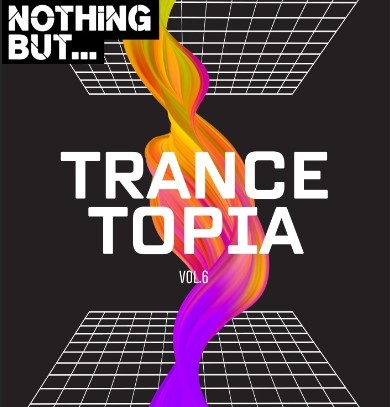
DATE CREATED: 2023-08-01
Tracklist :
DJ Miho - Angels Cry
Christina Ashlee - Kinetic Drive
Denis Airwave - Sputnik
Illaro - Phantom
Fischer & Miethig - Magic Destinations
Hypersia - Jouska
Fedo - Lost In Space
Quincy Weigert - Silhouette
Mindflux - Infiltrate My Mind
Master Beat Projekt - Adrenalin
Peer Vincent - Metastasis
Silent Space - Endless Space
Lewis Adam - Bring The Beat Back
Offshore Wind - DRIFT
Efemgie - One Chance
Misha Vorobjev - Fairytale
Stormline - Melancholy
Dark Matter - Temple Of The Sun
FAWZY - Digital Utopia
Atropate - Blood Diamonds
Marc Ward - Joy
John Grand - Fernet
Pink Pig - View Of The Sea
Independent Art - Vertical Love
Joseph Vega - Axiom
Download FileCat
Read the full article
0 notes
Text
Nothing But... Trancetopia, Vol. 06
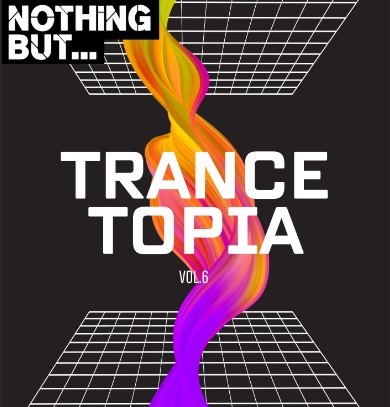
DATE CREATED: 2023-08-01
Tracklist :
DJ Miho - Angels Cry
Christina Ashlee - Kinetic Drive
Denis Airwave - Sputnik
Illaro - Phantom
Fischer & Miethig - Magic Destinations
Hypersia - Jouska
Fedo - Lost In Space
Quincy Weigert - Silhouette
Mindflux - Infiltrate My Mind
Master Beat Projekt - Adrenalin
Peer Vincent - Metastasis
Silent Space - Endless Space
Lewis Adam - Bring The Beat Back
Offshore Wind - DRIFT
Efemgie - One Chance
Misha Vorobjev - Fairytale
Stormline - Melancholy
Dark Matter - Temple Of The Sun
FAWZY - Digital Utopia
Atropate - Blood Diamonds
Marc Ward - Joy
John Grand - Fernet
Pink Pig - View Of The Sea
Independent Art - Vertical Love
Joseph Vega - Axiom
Download FileCat
Read the full article
0 notes
Text
Birthdays 7.11
Beer Birthdays
John Gardiner (1825)
Joseph "Papa Joe" Griesedieck (1863)
Harry A. Poth (1881)
Don Younger (1941)
Lisa Morrison (1963)
Mike “Scoats” Scotese (1965)
William Reed
Jennifer England; St. Pauli Girl 2011/12 (1978)
Five Favorite Birthdays
Andrew Bird; pop musician, violinist, songwriter (1973)
Yul Brynner; actor (1920)
Suzanne Vega; pop singer (1959)
James McNeil Whistler; artist (1834)
E.B. White (writer)
Famous Birthdays
John Quincy Adams; 6th U.S. President (1767)
Georgio Armani; Italian fashion designer (1934)
Harold Bloom; writer, critic (1930)
Thomas Bowdler; editor (1754)
Liona Boyd; classical guitarist (1949)
Jeff Hanna; rock guitarist (1947)
Tab Hunter; actor (1931)
Lil' Kim; rapper (975)
Peter Murphy; pop singer (1957)
William Osler; physician (1849)
Lisa Rinna; model, actor (1963)
Richie Sambora; rock guitarist (1959)
Leon Spinks; boxer (1953)
Mindy Stirling; actor (1953)
Suzanne Vega; pop singer (1959)
Harry von Zell; radio and television announcer (1906)
John Wanamaker; merchant (1838)
Sela Ward; actor (1956)
0 notes
Photo
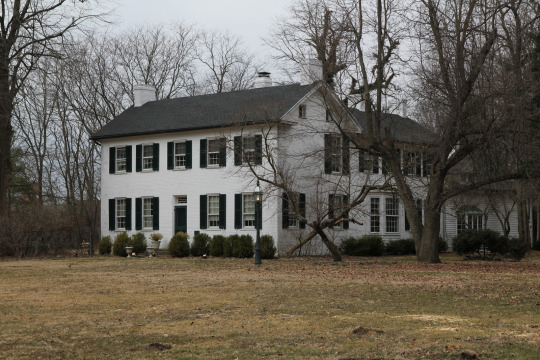
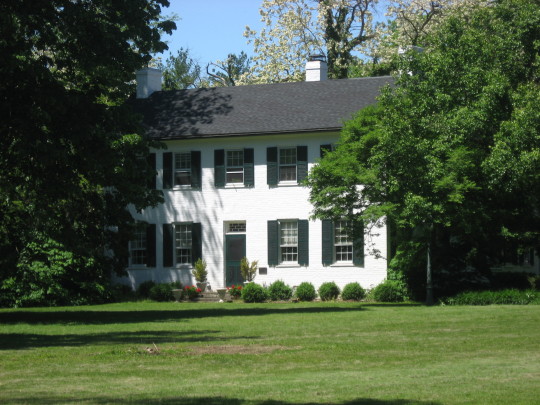
John Q.A. Ward House
335 College St.
Urbana, OH
he John Q.A. Ward House is the historic 1820 house in Urbana, Ohio, of a local sculptor. Located along College Street on the city's western side, it was built in 1820 by Colonel William Ward, the founder of Urbana, as a wedding present for his son, John Anderson Ward. John lived in the house until his death in 1855. The Ward House is historically significant for its early architecture. Based on a stone foundation, the brick house is a two-story structure built in an "L" plan.
John A. Ward's son, John Quincy Adams Ward, is the namesake of the house. A sculptor, Ward was known for multiple carvings of the Marquis de Lafayette, George Washington, and Oliver Hazard Perry. The well-preserved architecture, together with its connection to John Q.A. Ward and his wife Rachel Ward, led to the house's addition to the National Register of Historic Places on July 30, 1974.
1 note
·
View note
Photo

John Quincy Adams Ward (b.1830 - d.1910), 'The Freedman', bronze, c.1863 & cast c.1891, American, currently in the collection of the Metropolitan Museum of Art, New York, NY, USA.
Ward’s depiction of a seminude African-American man was inspired by President Abraham Lincoln’s Emancipation Proclamation, issued on September 22, 1862. Contemporary appreciation for “The Freedman” arose from the desire for statuary that addressed current issues in straightforward terms rather than through allegories. The muscular figure was executed with remarkable attention to anatomical accuracy. The broken manacles on the former enslaved man’s left wrist and in his right hand offer a succinct commentary on the chief political and moral topic of the era and clearly proclaim Ward’s abolitionist sentiments. (x)
22 notes
·
View notes
Photo
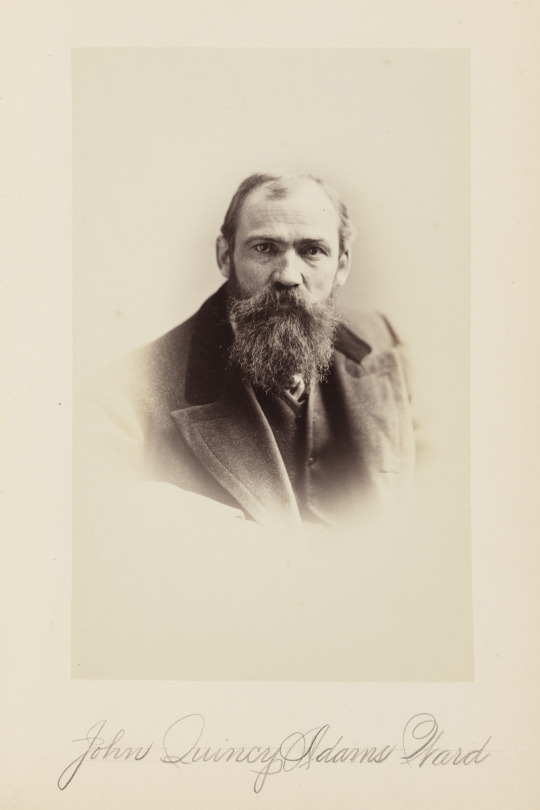
john quincy adams ward, napoleon sarony
2 notes
·
View notes
Photo
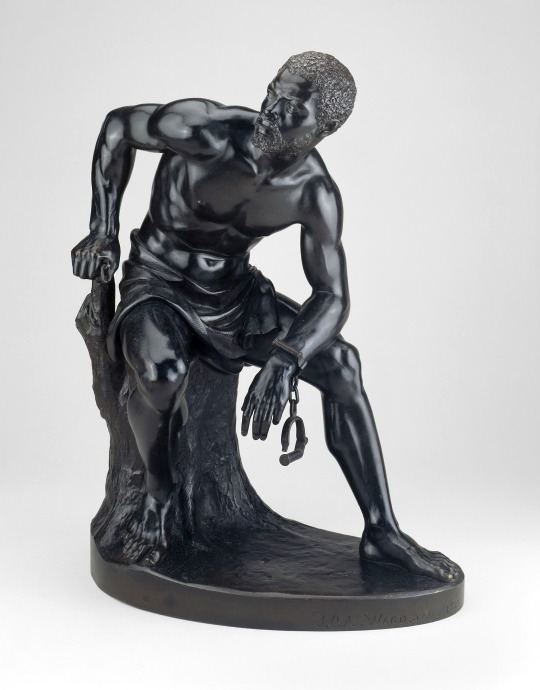
“The Freedman” (1863) by John Quincy Adams Ward (American, 1830-1910)
A leader among the nation’s second generation of sculptors, John Quincy Adams Ward played a significant role in elevating the medium in the United States, calling for a new realism to address moral concerns. Inspired by Abraham Lincoln’s 1862-63 Emancipation Proclamation, ‘The Freedman’ reflects not only Ward’s aspiration to create relevant statements on pressing issues of the day but also his abolitionist sentiments. Using antiquity as his inspiration, he depicted a seminude man seated on a tree stump who has just been liberated from the shackles that bound him to slavery. Ward broke artistic convention by showing the former slave as master of his own destiny, not a man reliant on white men for freedom. The vestiges of chains, potent symbols of his bondage, dangle from both wrists, and his muscular body, turned to look over his shoulder, is contained within a formal, triangular composition. ‘The Freedman’ was modelled from life and is generally considered the first and most accurate sculptural representation of an African-American. Shortly after The Freedman was first exhibited in 1863, art critic James Jackson Jarves effectively summarised the work’s power: “We have seen nothing in our sculpture more soul-lifting or more comprehensively eloquent. It tells in one word the whole sad story of slavery and the bright story of emancipation.”
3 notes
·
View notes
Text

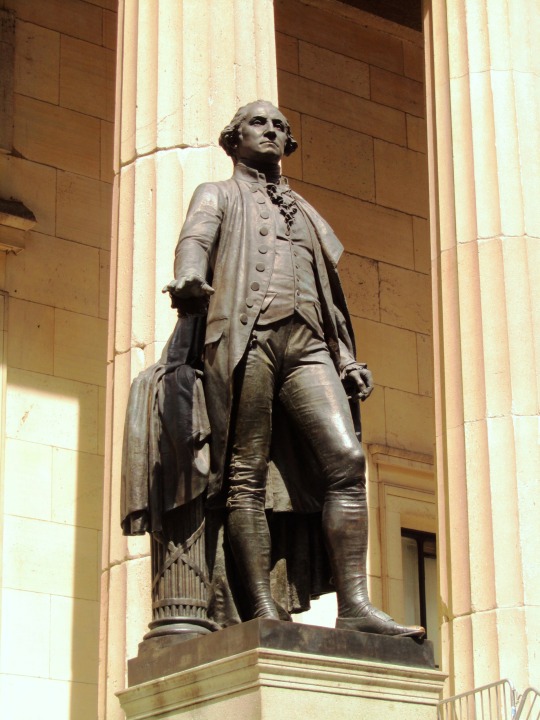



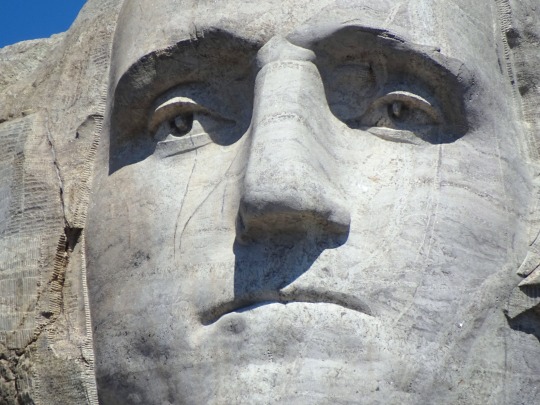









George Washington, American general and politician, first President of the United States, was born on February 22, 1732.
#George Washington#1st US President#born#290th birthday#US history#290th anniversary#Federal Hall National Memorial#Manhattan#New York City#Mount Rushmore National Memorial#Gutzon Borglum#South Dakota#travel#vacation#Henry Kirke Brown#Boston#Massachusetts#sculpture#public art#John Quincy Adams Ward#George Washington's Birthday#GeorgeWashingtonsBirthday#Thomas Ball#Chicago#Illinois#Herald Square Monument#Lorado Taft and Leonard Crunelle#Philadelphia#Pennsylvania#Joseph A. Bailly
2 notes
·
View notes
Photo

Henry Ward Beecher by John Quincy Adams Ward
1891; cast after 1910
https://www.metmuseum.org/art/collection/search/13136
0 notes
Photo

The Indian Hunter, John Quincy Adams Ward, 1860, cast before 1910, American Paintings and Sculpture
Morris K. Jesup Fund, 1973
Size: 16 1/8 x 10 1/2 x 15 1/4 in. (41 x 26.7 x 38.7 cm)
Medium: Bronze
https://www.metmuseum.org/art/collection/search/13137
53 notes
·
View notes
Photo
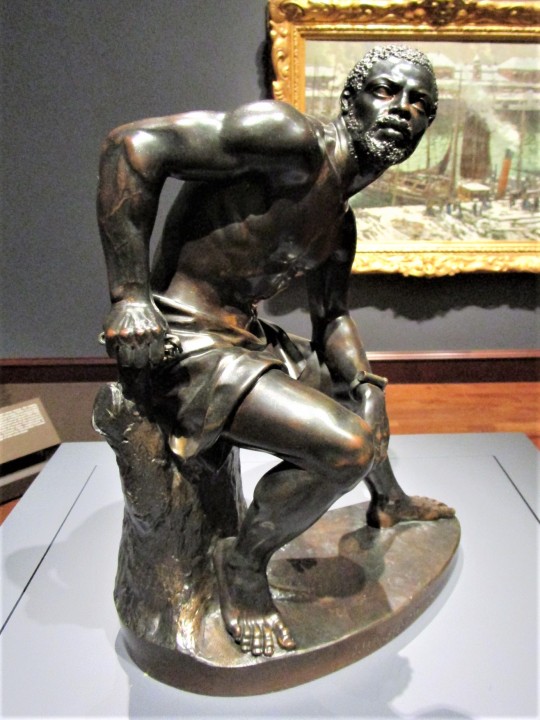
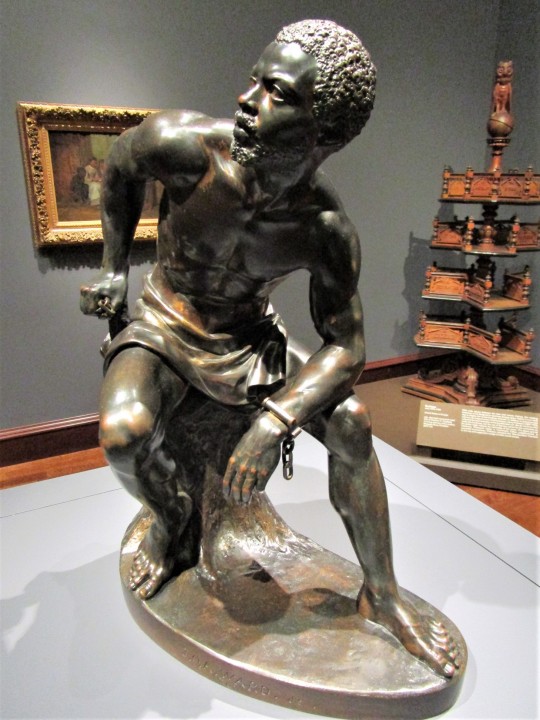
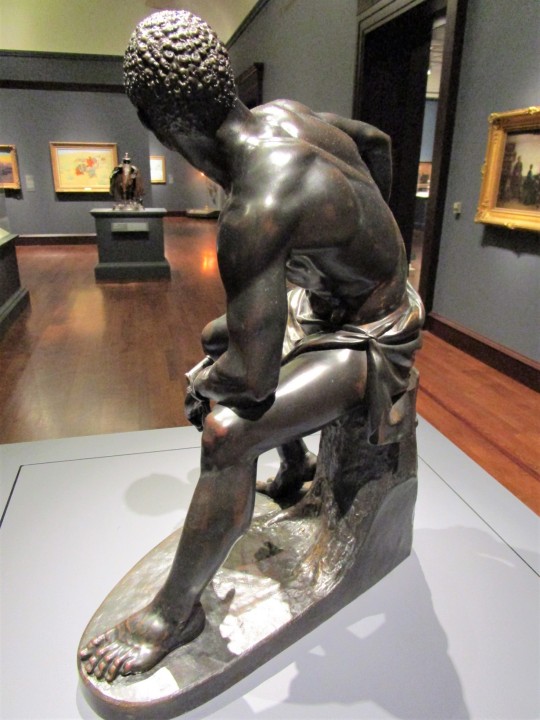
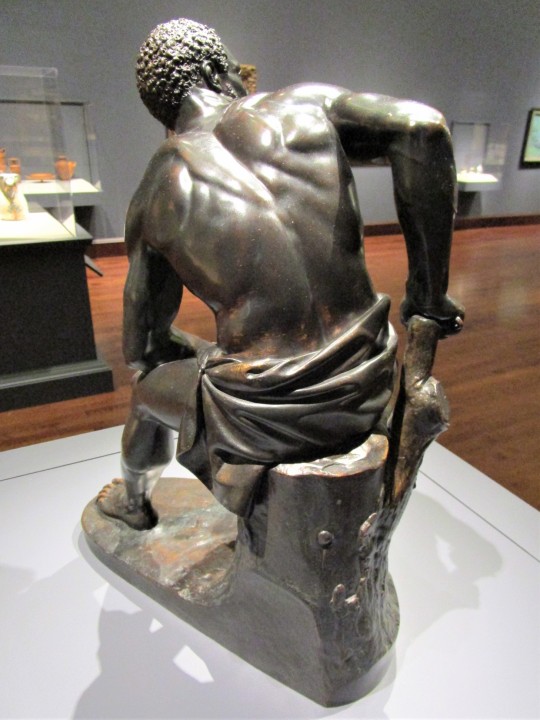
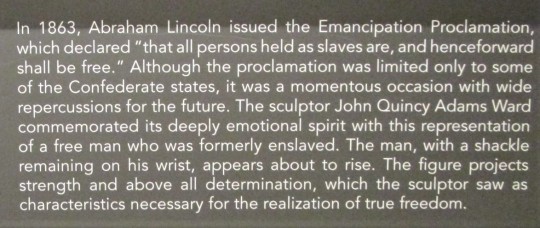
The Freedman, bronze, 1863, John Quincy Adams Ward
Cincinnati Art Museum
#bronze sculpture#American art#19th century art#emancipation#statue#enslaved people#Cincinnati#Ohio#fine art
54 notes
·
View notes
Photo
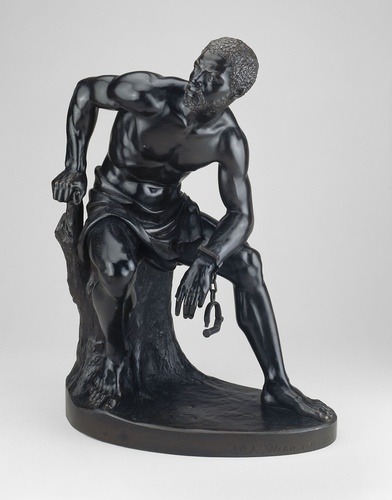
The Freedman, John Quincy Adams Ward, 1863, Art Institute of Chicago: American Art
A leader among the nation’s second generation of sculptors, John Quincy Adams Ward played a significant role in elevating the medium in the United States, calling for a new realism to address moral concerns. Inspired by Abraham Lincoln’s 1862–63 Emancipation Proclamation, The Freedman reflects not only Ward’s aspiration to create relevant statements on pressing issues of the day but also his abolitionist sentiments. Using antiquity as his inspiration, he depicted a seminude man seated on a tree stump who has just been liberated from the shackles that bound him to slavery. Ward broke artistic convention by showing the former enslaved person as master of his own destiny, not a man reliant on white men for freedom. The vestiges of chains, potent symbols of his bondage, dangle from both wrists, and his muscular body, turned to look over his shoulder, is contained within a formal, triangular composition. The Freedman was modeled from life and is generally considered among the first naturalistic sculptural representations of an African American. Shortly after The Freedman was first exhibited in 1863, art critic James Jackson Jarves effectively summarized the work’s power: “We have seen nothing in our sculpture more soul-lifting or more comprehensively eloquent. It tells in one word the whole sad story of slavery and the bright story of emancipation.” Roger McCormick Endowment
Size: 49.9 × 40 × 23.9 cm (19 5/8 × 15 3/4 × 9 3/8 in.)
Medium: Bronze
https://www.artic.edu/artworks/149776/
31 notes
·
View notes
Text
Birthdays 7.11
Beer Birthdays
John Gardiner (1825)
Joseph "Papa Joe" Griesedieck (1863)
Harry A. Poth (1881)
Don Younger (1941)
Lisa Morrison (1963)
Mike “Scoats” Scotese (1965)
William Reed
Jennifer England; St. Pauli Girl 2011/12 (1978)
Five Favorite Birthdays
Andrew Bird; pop musician, violinist, songwriter (1973)
Yul Brynner; actor (1920)
Suzanne Vega; pop singer (1959)
James McNeil Whistler; artist (1834)
E.B. White (writer)
Famous Birthdays
John Quincy Adams; 6th U.S. President (1767)
Georgio Armani; Italian fashion designer (1934)
Harold Bloom; writer, critic (1930)
Thomas Bowdler; editor (1754)
Liona Boyd; classical guitarist (1949)
Jeff Hanna; rock guitarist (1947)
Tab Hunter; actor (1931)
Lil' Kim; rapper (975)
Peter Murphy; pop singer (1957)
William Osler; physician (1849)
Lisa Rinna; model, actor (1963)
Richie Sambora; rock guitarist (1959)
Leon Spinks; boxer (1953)
Mindy Stirling; actor (1953)
Suzanne Vega; pop singer (1959)
Harry von Zell; radio and television announcer (1906)
John Wanamaker; merchant (1838)
Sela Ward; actor (1956)
0 notes